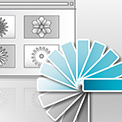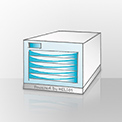Notes on HELIOS Server Virtualization
Introduction
Supported virtualization solutions
Virtualization products and HELIOS machine ID USB dongle
Tested virtualization products
What we tested
Tested hardware
Server hardware requirements
Virtualization installation notes
Virtualization administration notes
Guest OS support
Guest OS installation
Microsoft Hyper-V exporting / importing VMs notes
HELIOS machine ID (x86 VMs)
Performance notes
Q & A
Introduction
Server virtualization is the technology that enables one or more “virtual machines” to run on a single physical host server. A virtual machine (VM) encapsulates an operating system, together with any desired applications, and generally has all unnecessary services turned off. This allows easier maintenance, and greater security. Virtual machines can also make backup, restoring, load balancing, and failover of systems easier. Another advantage of VMs is that multiple virtual machines can be run on the same host system, while preserving the isolation of services. For example, several instances of Linux, Windows, and Solaris can run simultaneously on the same server hardware. This allows consolidation of hardware systems, for better utilization, and lower maintenance and energy costs.
Virtualization has become a critical technology. Systems such as VMware ESX Server and Microsoft Hyper-V allow running multiple virtual machine guest systems on a server. HELIOS has added support to ensure that HELIOS Server Solution products can run in virtual machines. The high availability and load balancing options of the virtualization vendors are supported, allowing for the most flexible usage of hardware resources. Exporting and importing entire VMs allows quickly moving an entire server configuration to new hardware.
Product page: HELIOS Virtual Server Appliance
The following sections explain how HELIOS supports various virtualization products.
Supported virtualization solutions
HELIOS tested virtualization solutions from IBM, Microsoft and VMware for inclusion in the official HELIOS supported platform list:
|
Host OS |
Guest OS |
Comment |
| VMware ESX Server | Windows Server 2008 / 2012 / 2016 / 2019, Linux, Solaris | HELIOS UB2 and later |
|
Microsoft Hyper-V Server |
Windows Server 2008 / 2012 / 2016 / 2019, Linux, Solaris |
HELIOS UB64 |
|
IBM PowerVM (IVM) |
IBM AIX 5.3 ML4 and newer, AIX 6, AIX 7 |
*Deprecated |
| Citrix XenServer* | Windows Server 2008 / 2012, Linux, Solaris | *Deprecated |
Tested native host OS and guest OS
VMware ESX Server represents a virtualization platform powered by a proprietary Linux-based OS. Administration is provided by a web application.
Microsoft Hyper-V Server represents a virtualization platform powered by a Windows Server 2008 or newer Standard OS. Hyper-V runs as a service on top of Windows.
Virtualization products and HELIOS machine ID USB dongle
Depending on the virtualization solution, product version and hardware environment USB devices may not be supported within virtual machines. Thus, a HELIOS machine ID USB dongle is also not visible inside these VMs. Starting with CD024, HELIOS products can be licensed for these VM-based OS installations.
Tested virtualization products
- VMware vSphere/ESXi 4, 5, 6
- Hyper-V on Microsoft Windows Server 2008/2012/2016/2019
Time-limited evaluation versions are available from the vendor.
Freely available virtualization products are:
- VMware ESX
- Microsoft Hyper-V Server
For information on product versions, feature set, licensing, and pricing check the web sites of the vendors:
http://www.vmware.com/products/vi/esx
http://www.microsoft.com/servers/hyper-v-server/default.mspx
For a comparison between VMware ESX and ESXi see:
http://www.vmware.com/products/vsphere/esxi-and-esx/compare.html
For a comparison between Microsoft Windows Server 2008 and Microsoft Hyper-V Server 2008 see:
http://www.microsoft.com/servers/hyper-v-server/default.mspx
What we tested
General installation and operation of HELIOS UB+ (since CD024) products were tested.
As long as the OS in the VM is properly set up and running, e.g. disk and network devices are working properly, HELIOS installation and startup is the same as installing on a physical computer.
The guest OS inside each VM should be up-to-date with all current updates installed and activated.
- ESX Server and Hyper-V Server on Intel- and AMD-based servers
ESX
- Basic ESX can also be installed on 64-bit system without direct virtualization support. Advanced features and add-on products of the VMware Infrastructure product line can have more specific requirements
- Installation requires and overwrites complete disk
Hyper-V
- 64-bit system with Intel VT or AMD Virtualization, Intel XD or AMD NX bit enabled (may need to be enabled in BIOS first)
- Can be installed in an already existing disk partition
Virtualization installation notes
- ESX installation and configuration is straightforward
Windows Server 2008 (x64; full installation) with Hyper-V is a regular server installation with the role of Hyper-V enabled
-
Hyper-V Server 2008 is a regular x64 core installation with only the Hyper-V role available
A “core” installation does omit all GUI tools and makes use of shell commands. A shell command based tool will guide you through the computer configuration, e.g. setting computer name, network configuration etc.
Installing and enabling the Hyper-V role is documented by Microsoft. For details see: http://technet.microsoft.com/en-us/library/cc753802.aspx - Make sure to apply all available Microsoft updates after installation. Apply even optional ones, as Hyper-V related updates may be optional
Virtualization administration notes
VMware
After ESX is installed and started, an administration web interface can be accessed from any client on the network by entering the server's host name or IP address in a current web browser
Additional features like VM migration across ESX Servers require the VMware Infrastructure Client administration tool which is part of the VMware Infrastructure products
Hyper-V
- A Windows GUI administration tool is used to manage VMs on a Windows Server
- On a Hyper-V Server 2008 (which is a core installation without GUI tools) Hyper-V configuration is not possible directly on the server. A separate Windows Server or Windows workstation is required to run the GUI administration program remotely
Guest OS support
IBM, Microsoft and VMware provide a list of supported guest operating systems for their virtualization solutions, as well as available features such as the number of CPUs for the guest OS.
For an OS not on the supported list, Microsoft and VMware recommend to check their discussion forums for other customer success stories with installing that OS.
HELIOS tested the guest OSs listed in the table above. Check with the virtualization product vendor for OS support.
VMware
Converted already available VM images with “VMware-converter” from an AMD PC running VMware Workstation 6 to the ESXi server
- SUSE / Red Hat Linux
- Windows Server
- Solaris
Hyper-V
Installed guest OS from standard distribution CDs
- Windows Server
- Solaris
- SUSE / Red Hat Linux
When available for the installed guest OS, so called “integration services” should be installed to smooth keyboard and mouse user experience as well as gain a performance increase.
Microsoft Hyper-V exporting / importing VMs notes
- VMs have to be stored on an NTFS file system in order to be activated
- Exporting VMs will generate a directory tree with the necessary files
- Importing VMs requires the same directory structure as was exported. During import, the directory tree will become the store location of the new VM. After the import, the directory tree can not be copied and imported again. If a backup is required, first make a copy and then import the VM
- Exporting VMs will only work when the destination directory is on NTFS, not FAT or CIFS
- Importing VMs will only work when the source directory is on NTFS, not FAT or CIFS
- The HELIOS machine ID is based on VM specific information as well as the network hardware MAC address of the VM
- Exporting a VM and importing (migrate) it again will keep the same machine ID as long as the imported machine keeps the same network hardware MAC address and VM specific information
- When installing the same OS a second time into a new VM, then the new VM receives a different HELIOS machine ID
- Depending on settings for the VMs, when starting a VM it may get a new unique MAC address assigned in case there is already a VM with that MAC address active
For production environments it is required to conduct representative tests to determine whether the chosen virtualization solution and guest OS meet the needs in feature set and performance.
For some first tests you can use HELIOS tools and sample data, for example:
|
CPU performance: |
“imageconv” |
|
Network performance: |
LanTest |
|
Disk performace: |
“dd” on UNIX and HELIOS “dd” on Windows with 10 GB data, e.g.:
|
- Does macOS for Intel run in one of the supported VMs? Not supported by Apple nor HELIOS.
-
Is VMware Server / Workstation / Fusion supported? The HELIOS USB machine ID dongle works.
These solutions may be good for testing.
However they are not supported by HELIOS for production environments. -
Is Parallels Mac Server or Workstation supported? The HELIOS USB machine ID dongle works.
These solutions may be good for testing.
However they are not supported by HELIOS for production environments. - Is Microsoft Virtual Server 2003 supported? Not tested nor supported by HELIOS.
- Is Oracle VirtualBox supported? Not tested nor supported by HELIOS.
-
Is Solaris Zones supported? This is not hardware virtualization.
HELIOS products installed in the root zone will work.
Using HELIOS products in other zones is not supported. - Can I run EtherShare 3 times on the same virtualization server? Yes. However, each instance of a guest OS needs its own EtherShare license / serial number.
-
Whom to contact with support problems?
- If you have encountered a problem with the native OS running the VMs contact the VM vendor
- If you have encountered a problem with the guest OS running in the VMs contact the guest OS vendor
- If you have encountered a problem with the HELIOS products contact your HELIOS partner
- Can I deploy a 400 user virtualized server? For heavy-load, native hardware will perform much better and the OS will be supported by the hardware vendor directly. We recommend to test server virtualization before deployment.
- Will virtualization high availability work? HELIOS software is prepared to work in such environments. Consult your VM vendor for advice and additional information.
- How much will the HELIOS virtualization support cost? No additional costs for existing customers with a Software Upgrade Service agreement. Customers will receive the current HELIOS CD as part of their subscription. New customers receive this automatically with their purchase. Customers with older product versions, or without Software Upgrade Service agreements should contact their HELIOS partner for pricing details.

 Enterprise Server
Enterprise Server
 Developers / SDK
Developers / SDK
 Retail / Industrial
Retail / Industrial
 Newspapers / Publishers
Newspapers / Publishers
 Photographer / Studios
Photographer / Studios
 Ad Agencies / Premedia / Printers
Ad Agencies / Premedia / Printers
 Video & Entertainment
Video & Entertainment
 Cloud Collaboration
Cloud Collaboration
 HD Color
HD Color
 Image Processing
Image Processing
 Proofing
Proofing
 WebShare Connectivity
WebShare Connectivity
 Workflow Automation
Workflow Automation
 File Server
File Server
 Press Releases
Press Releases  Videos
Videos  Newsletters
Newsletters  Events
Events